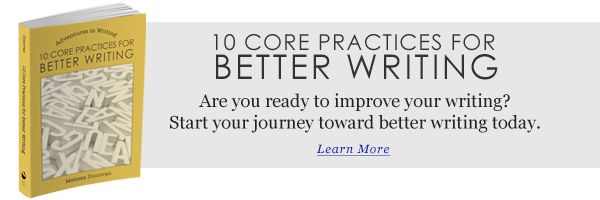Have you ever stopped to think about how many different types of writers there are? Novelists, biographers, bloggers, copywriters, poets, screenwriters, and playwrights — just to name a few. Within each type of writing we can find areas of specialization. Some biographers write about celebrities; others focus on politicians. Copywriters can specialize in ad copy or web content. Fiction breaks down into dozens of genres and sub-genres. When you stop to think about it, the world of writing is quite diverse.
But one thing connects all writers: using language as a tool for creation and communication.
Every writer, regardless of what they write, strings words together in an effort to render a desired effect on the reader. Whether we’re trying to stir emotions, entertain, persuade, or inform, words are the foundation — the core building blocks — of our work. And there’s a lot we can do to maximize the resonance of those words by selecting and arranging them with care.
Crafting Language
Here are some simple and straightforward tips to help you craft language that resonates with readers:
- Avoid weak words: Very, really, and the verbs to be, to have, and to do are often markers of weak, amateur writing. Sometimes we need to use these words, but there is often a more specific or vivid word available. Very intense training is better expressed as vigorous training.
- Stay away from passive voice: Constructions such as The book was read by the girl tend to sound outdated and convoluted, awkward and verbose. Active voice is better: The girl read the book.
- Watch your pronouns: Too many pronouns in a sentence cause confusion and make it difficult for the reader to keep track of who is saying and doing what. Use a noun or a name first, and then use pronouns to refer back to whomever (or whatever) you’re writing about.
- Extraneous words (verbiage): Verbiage is not text or writing; it is extraneous, unnecessary language. The best sentences and paragraphs contain only words that are absolutely necessary. They communicate as simply and straightforwardly as possible. Cut the excess!
- Missing words: Occasionally writers will leave out bits of detail, often because they forget or don’t realize that they have more knowledge about a subject (or a story) than their readers. While it’s always safe to assume your readers are as smart (or smarter) than you, don’t assume they know everything about your story world or subject matter. Sometimes the slightest missing detail can mean the difference between a reader being able to visualize something and struggling to understand it.
- Create images with your words: In writer’s jargon, we call this “show, don’t tell.” Use language to help readers visualize the scenes or concepts that you’re trying to convey.
- Avoid adverbs: Sometimes adverbs are necessary, but most of the time they weaken and clutter up a sentence. People don’t run fast; they sprint.
- Use adjectives with caution: Adjectives cannot be avoided — they are essential, especially for creating imagery and providing accurate, vivid descriptions. But some adjectives are unnecessary and therefore result in sloppy work: pale green should be mint or sage.
- Read aloud to test the flow: Don’t underestimate the power of musicality in a piece of writing. The best test is to read everything you write aloud to see how it rolls off the tongue. Does it have cadence and melody? You’re good to go. Does it clank and drone? More revision is necessary.
- In prose, alternate between long and short sentences. This helps a lot with musicality because it gives your language rhythm and texture.
Writing as Craft
Merriam-Webster’s defines craft as follows:
1 : skill in planning, making, or executing : dexterity.
2 : an occupation or trade requiring manual dexterity or artistic skill.
Many forms of writing are imbibed with artistry, but at its heart, writing is craft. The craft of writing requires that we develop the skills to master language. We need to learn how to bend and shape language to our will, in a way that has the desired effect on a reader. Poor word choices, clunky sentences, and confusing paragraphs are the red flags of poorly crafted language, which weakens a writer’s work. Writers need to focus on content, the substance of what they’re communicating, but the content and substance can be drowned out by poor language, which is why investing in studying and mastering language is critical to the craft.
What’s your relationship with language? Do you search the perfect word? Are you moved by a beautifully structured sentence? Do you cringe at poorly crafted language? Do you work to produce clear, crisp and vidi prose or poetry? Share your thoughts by leaving a comment, and keep writing.






I’m always searching for the perfect words…currently working on my first poetry collection. Thanks for the great tips–saving and sharing them!
Thanks for your kind words, Bette.
Quite right about everything you said.
Personally, though, I have a thing about prepositions. So many times they aren’t needed.